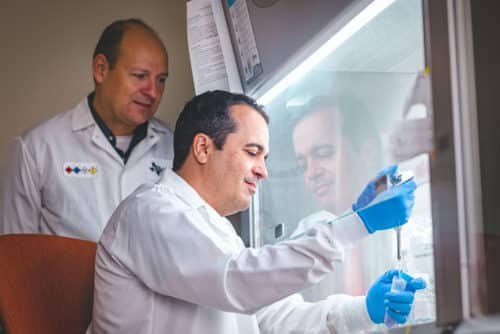A group of researchers from the University of Texas at Dallas has created a first-of-its-kind approach for creating a unique identification for each clone of a cell line, allowing consumers to verify its legitimacy while also protecting the manufacturer’s intellectual property (IP).

An interdisciplinary partnership between UT Dallas faculty members produced the patent-pending technology. Dr Leonidas Bleris, a professor of bioengineering who specialises in genetic engineering, and Dr Yiorgos Makris, a professor of electrical and computer engineering who specialises in electronics hardware security, are the study’s co-corresponding authors.
Physically unclonable functionalities (PUFs) in the electronics sector motivated the UT Dallas engineers’ effort to establish unique IDs for genetically modified cells. A PUF is a physical property that can be used to identify a semiconductor device, such as a microprocessor. PUFs are based on natural variances that occur throughout the manufacturing process in semiconductors and must meet three requirements: they must have a unique fingerprint, create the same fingerprint each time they are measured, and be virtually impossible to replicate.
To apply that idea to created cells, the researchers devised a two-step procedure that takes advantage of a cell’s ability to repair damaged DNA, which is made up of nucleotide sequences. “We need a way to differentiate between 1,000 copies of the same product. Even though the products are identical, each of them has a unique identifier, which cannot be replicated,” says Dr Leonidas Bleris, the Cecil H. and Ida Green Professor in Systems Biology Science in the Erik Jonsson School of Engineering and Computer Science.
They started by inserting a five-nucleotide barcode library into a safe harbour region of the cell’s DNA, where the change will not harm the cell. However, barcodes alone do not satisfy the three PUF criteria. The researchers then utilised the gene-editing technology CRISPR to cut the DNA near the barcode in the second stage. This causes the cell to use random nucleotides to repair its DNA, a process known as nonhomologous error repair.
The cell naturally inserts new nucleotides into the DNA and/or deletes others during this repair process, which is referred to as indels (insertions/deletions). These random repairs, when combined with the barcodes, produce a distinct nucleotide pattern that can be used to distinguish one cell line from another.
“The combination of barcoding with the inherently stochastic cellular error repair process results in a unique and irreproducible fingerprint,” said Dr Leonidas Bleris, the Cecil H. and Ida Green Professor in Systems Biology Science in the Erik Jonsson School of Engineering and Computer Science. Researchers can use this first generation of CRISPR-engineered PUFs to authenticate that the cells were created by a certain company or lab, a procedure known as provenance attestation. The engineers hope to establish a way for measuring the age of a specific clone of a cell line with more study.








